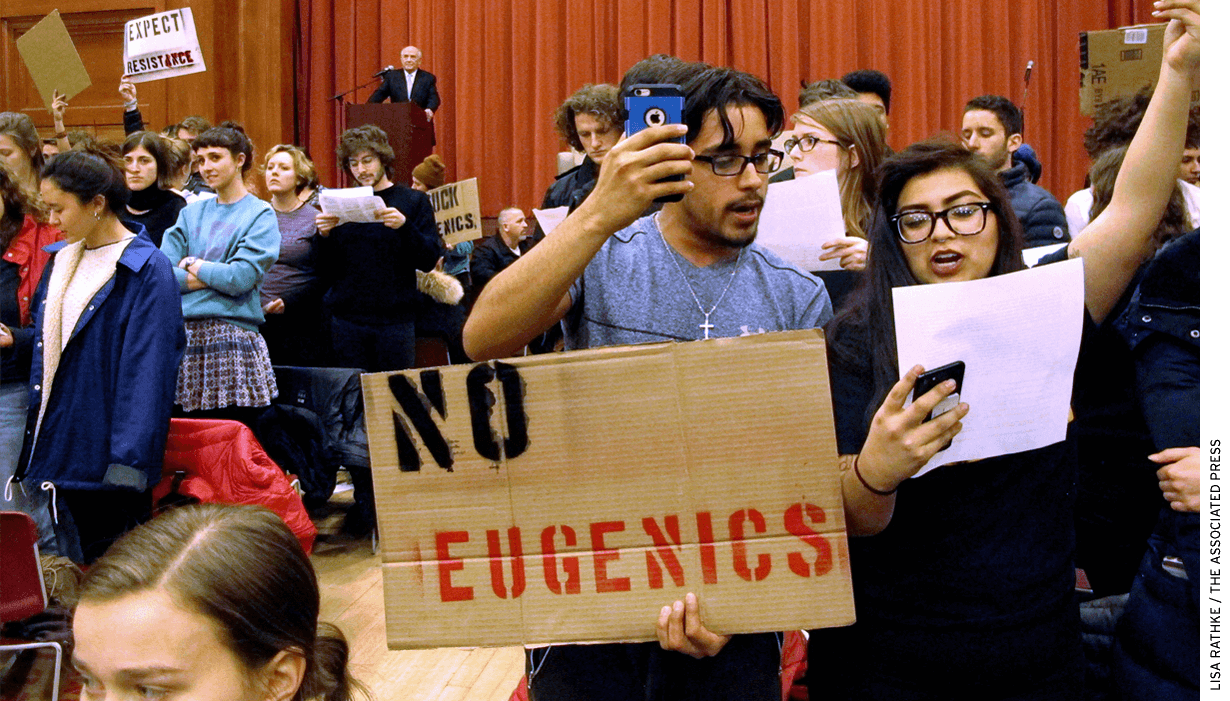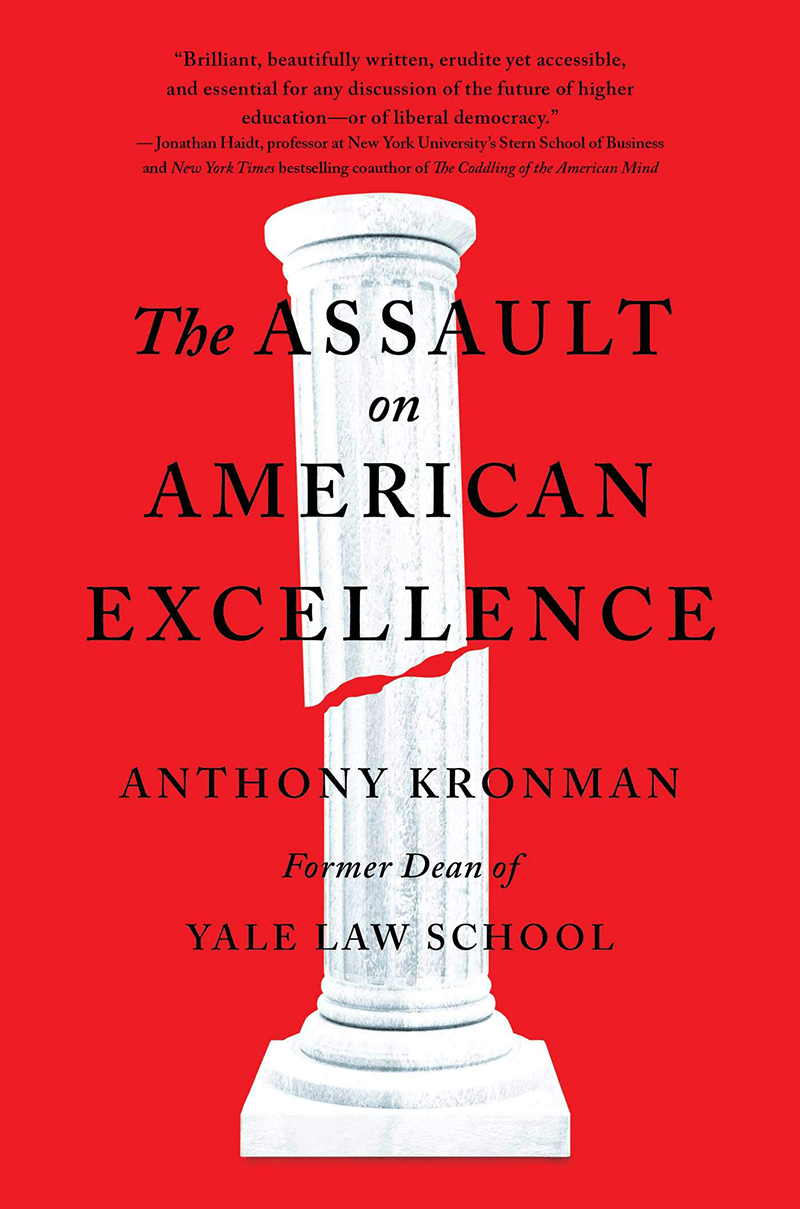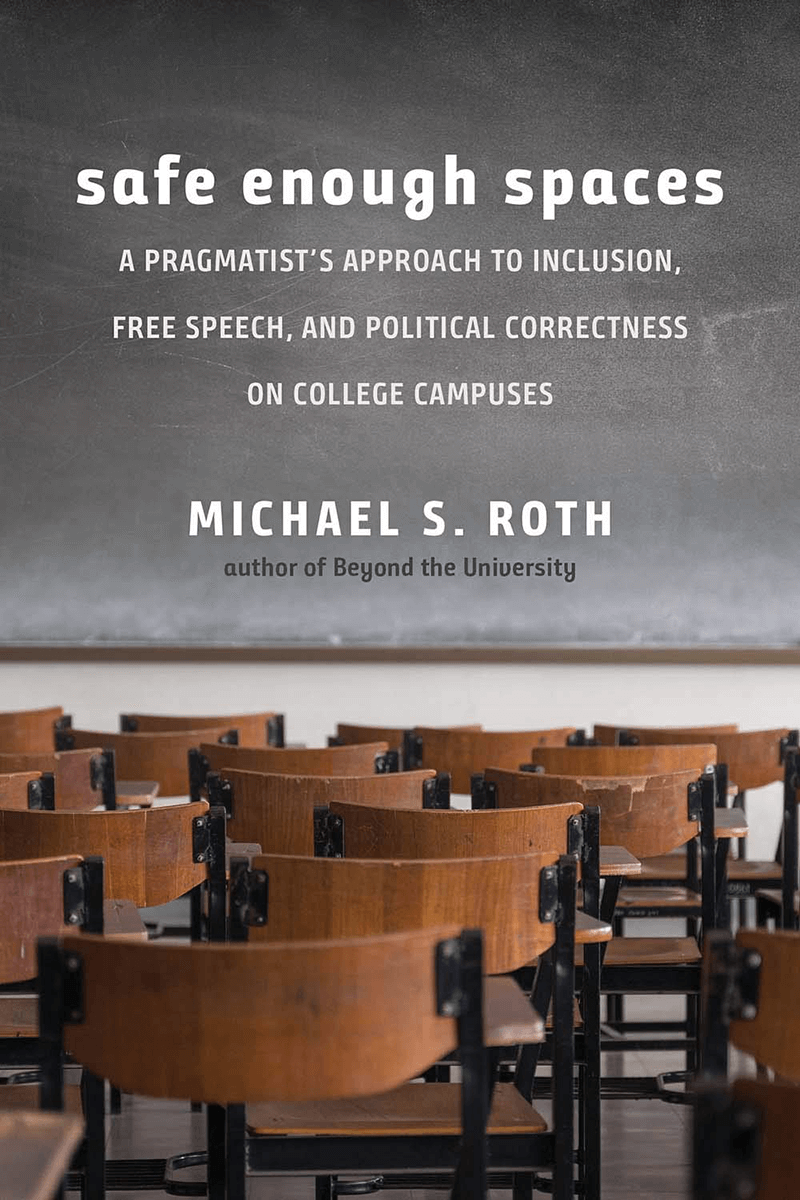
The Assault on American Excellence
By Anthony Kronman
Free Press, 2019, $27, 288 pages
Safe Enough Spaces: A Pragmatist’s Approach to Inclusion, Free Speech, and Political Correctness on College Campuses
By Michael Roth
Yale University Press, 2019, $25, 160 pages
As reviewed by Mark Bauerlein
The first thing that strikes you in Anthony Kronman’s study of higher education is the archaic language. Academics generally believe that education should undercut “privilege,” but in the Introduction Kronman claims, “in our democracy it is essential to preserve a few islands of aristocratic spirit.” Indeed, he writes, “our colleges and universities must be insulated against the passion for equality.”
To those of us in the humanities, the idiom seems way out-of-date. When a few colleagues and I approached our dean with an idea for a Great Books program and he suggested we drop the word great from the plan, he was merely voicing standard dogma, but to Kronman, “part of the work of our most distinguished institutions of higher learning is to preserve, transmit, and honor an aristocratic tradition of respect for human greatness.” Moreover, the capacity to enjoy the finer things is “more developed in some souls than others.” Kronman even speaks of “an aristocracy of truth-seekers,” sounding more like Nietzsche than a man who was dean of Yale Law School.
 Academics aren’t supposed to talk this way. They consider “greatness” and aristocracy insidious. This “assault” on excellence and hierarchy—Kronman calls it a national “frenzy” of “inclusion” and “tolerance”—has transformed academia into a “democracy of sentiment” that, respecting everyone’s feelings, eschews distinctions of value and standing. Hence, academics do things such as drop the name “Master,” as did a master at Pierson College, Yale, in 2015 in order to, as Kronman describes it, “avoid even the possibility of giving offense to those who might associate his title with the racism and hierarchy of the antebellum South.”
Academics aren’t supposed to talk this way. They consider “greatness” and aristocracy insidious. This “assault” on excellence and hierarchy—Kronman calls it a national “frenzy” of “inclusion” and “tolerance”—has transformed academia into a “democracy of sentiment” that, respecting everyone’s feelings, eschews distinctions of value and standing. Hence, academics do things such as drop the name “Master,” as did a master at Pierson College, Yale, in 2015 in order to, as Kronman describes it, “avoid even the possibility of giving offense to those who might associate his title with the racism and hierarchy of the antebellum South.”
Such gestures illustrate a fundamental error of the 21st-century college: importing egalitarian norms into an enclave that is justly aristocratic. Kronman is a forthright liberal—“I still endorse progressive positions on the whole” and he shows it by blaming Milo Yiannapoulos for the riots that accompanied his appearance at Berkeley, not the rioters themselves. But he insists that academia operate on other premises. It should maintain “reverence for human excellence,” resist “the undertow of popular opinion,” and yield “the cultivation of superior souls.” Kronman draws those virtues from Oliver Wendell Holmes, Tocqueville, John Adams, Irving Babbitt, and H.L. Mencken, men suspicious of democratic norms in art, philosophy, and science. If we don’t maintain excellence in the culture/education sphere, they warned, democracy decays into demagoguery. “Instead of disowning their elitism,” Kronman urges his colleagues, “they ought to embrace it.”
This won’t happen, though. Kronman says, “There is no reason I can see why one cannot be a democrat beyond the walls of the academy and an aristocrat within them,” but that separation was a prime target of progressives who took over the campus in the 70s and 80s and rule it still. His resurrection of aristocratic intellectual values won’t convince them one bit. “Everything is political,” they repeat. Anyone who belies this root conviction by compartmentalizing human activity only earns the disapproval of his colleagues, and nothing in academia is more frightening than that.
In Safe Enough Spaces, Michael Roth, the president of Wesleyan University, doesn’t force such confrontations. His goal is to lighten our alarm at the illiberal trends underway and give a modest apologia for diversity, political correctness, and safe spaces.
Straight off, he reiterates the diversity rationale: “Racial, ethnic, religious, and economic diversities on campus increase the likelihood that students and teachers will hear different points of view, encounter a variety of experiences, and forge more inclusive projects . . ..”
 Roth doesn’t provide evidence for this assurance, nor does he explain how, in spite of greater diversity in higher education, the campus feels more coercive and dogmatic than it did 30 years ago. He hails, too, a “diverse campus community in which people can learn from their differences while forming new modes of commonality,” but doesn’t provide any tales of unum forming out of the pluribus. He doesn’t think much of the University of Chicago statement against “trigger warnings,” either, such gestures raising, in his view, the “bogeyman of political correctness.”
Roth doesn’t provide evidence for this assurance, nor does he explain how, in spite of greater diversity in higher education, the campus feels more coercive and dogmatic than it did 30 years ago. He hails, too, a “diverse campus community in which people can learn from their differences while forming new modes of commonality,” but doesn’t provide any tales of unum forming out of the pluribus. He doesn’t think much of the University of Chicago statement against “trigger warnings,” either, such gestures raising, in his view, the “bogeyman of political correctness.”
The “bogeyman” label (which echoes elsewhere in the book) implies that Roth doesn’t credit the threats to academic freedom and hierarchy that trouble Kronman. For instance, he mentions protesters at Reed College who denounced the introductory Western Civ class as white supremacy, adding that Reed changed the requirement so that students could fulfill it with a course on Mexico City from colonization to independence or Harlem in the 1920s. That students marched into classrooms, hijacked the podium, and intimidated teachers doesn’t seem to bother him.
It is the psychological well-being of students that matters most, in this view. Roth frames complaints about political correctness as a case of insiders who resist “the young or other people new to the debate.” Haidt and Lukianoff’s The Coddling of the American Mind he interprets as a cliché: “Middle-aged men find the ways of college students alien, and this makes them feel out of touch.” He acknowledges the “lefty consensus” on campus and regrets identity politics and the disruptions they cause—“there’s no denying that there is a serious problem of political bias on college campuses”—but he treats them as minor issues that can be managed pragmatically. We don’t need to focus on “how to overcome identity politics. The great issue for liberals and conservatives alike is how to overcome inequality.” That’s what troubles the fractious undergraduates, you see. They aren’t bullies: “I don’t know anyone who doesn’t believe that the right to express oneself is important.”
Tell that to Charles Murray after his visit to Middlebury, or Camille Paglia whose classroom was recently shut down by students who pulled a fire alarm and screamed insults at her. True, Murray and Paglia haven’t been de-platformed—they’re just as famous as ever. But the students who came to hear them certainly took a lesson from the disruptions: be very careful what you say on this campus.
This unwillingness to appreciate the force of PC makes Safe Enough Spaces a disappointment, especially because the author is one of the most intellectual college presidents in the U.S., a figure admirably honest about the dangers of political hegemony. In a 2017 op-ed in the Wall Street Journal, he asserted that higher education needs “deeper intellectual and political diversity . . . an affirmative-action program for the full range of conservative ideas and traditions.” In his commencement address last May, he saluted activist students for their struggle against inequality, but also conservative students who “taught me to be mindful that even well-intentioned policies can undermine our freedoms.” He has enabled more veterans to attend Wesleyan. His books cover Hegel and Freud, French intellectual history and trauma theory, and he continues to teach classes while leading a university with a $1.06 billion endowment.
In this book, however, President Roth chooses the orthodox path, giving social justice passions a compassionate sheen and charting a pragmatic way through the tensions free speech vs. hate speech, safety vs. rigor. It won’t work. Many Americans have condemned campus PC for 30 years ever since The Closing of the American Mind came out (Roth devotes several pages to it), but PC has only gotten worse. There is no way to debate or reason it out of the system. If all professors and administrators were like President Roth, we wouldn’t have a problem. But they’re not.
Mark Bauerlein is professor emeritus of English at Emory University.


